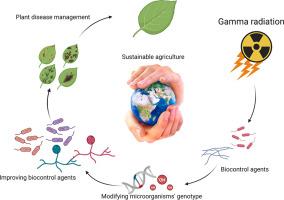Gamma radiation-induced enhancement of biocontrol agents for plant disease management
IF 4.8
Q1 MICROBIOLOGY
引用次数: 0
Abstract
Gamma radiation-induced mutations in microorganisms can enhance their properties for the biological control of plant diseases. Mutant strains of Bacillus subtilis were found to have improved antifungal properties against Aspergillus flavus and increased production of biosurfactants and biofilms. Furthermore, combining gamma radiation with antagonists was more effective in controlling Penicillium expansum postharvest than either treatment alone. A major focus of this research was on Trichoderma species, which have shown an enhanced ability to control plant diseases through increased production of antifungal metabolites such as hydrolytic enzymes, antibiotics, and total phenols. The mechanism by which gamma radiation alters the genotype of microorganisms is the destruction of double-stranded and single-stranded DNA, resulting in changes in the genome or nucleic acid molecule, altering the antagonistic properties of microorganisms. Sensitivity to radiation is determined by the size of an organism's chromosomes, and the effect on microorganisms is primarily based on DNA or RNA disruption. Molecular analysis of gamma radiation mutants has been used to understand changes in genome composition, including downregulated genes related to secondary metabolism, cytochrome P450 s, carbohydrate-active enzymes, peptidases, and hydrophobins. Gamma radiation thus offers a promising method to induce beneficial genetic changes in microorganisms, enhancing their efficacy in the biological control of plant diseases.

伽马辐射诱导生物控制剂增强植物病害管理能力
伽马辐射诱导的微生物突变可增强其生物防治植物病害的特性。研究发现,枯草芽孢杆菌的突变菌株对黄曲霉的抗真菌特性有所改善,生物表面活性剂和生物膜的产量也有所增加。此外,将伽马射线与拮抗剂结合使用比单独使用其中一种方法更能有效控制收获后的扩张青霉。这项研究的重点是毛霉菌种,这些菌种通过增加水解酶、抗生素和总酚等抗真菌代谢物的产量,提高了控制植物病害的能力。伽马辐射改变微生物基因型的机制是破坏双链和单链 DNA,导致基因组或核酸分子发生变化,从而改变微生物的拮抗特性。对辐射的敏感性由生物染色体的大小决定,对微生物的影响主要基于 DNA 或 RNA 的破坏。对伽马辐射突变体的分子分析已被用于了解基因组组成的变化,包括与次级代谢、细胞色素 P450s、碳水化合物活性酶、肽酶和疏水性蛋白有关的下调基因。因此,伽马辐射为诱导微生物发生有益的基因变化提供了一种很有前途的方法,从而提高了微生物在植物病害生物防治方面的功效。
本文章由计算机程序翻译,如有差异,请以英文原文为准。
求助全文
约1分钟内获得全文
求助全文
来源期刊

Current Research in Microbial Sciences
Immunology and Microbiology-Immunology and Microbiology (miscellaneous)
CiteScore
7.90
自引率
0.00%
发文量
81
审稿时长
66 days
 求助内容:
求助内容: 应助结果提醒方式:
应助结果提醒方式:


